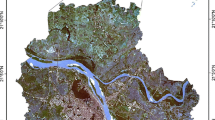Abstract
There are many factors that can affect the urban growth and it has great implications towards socio-economic for the related areas. Usually, the urban planning and monitoring are performed and administered by the local authorities for improvement and development purposes. This research focuses on analyzing the urban growth of Klang Valley in Malaysia (a developing country), where this is the most rapid growth area in the country. This area is divided into ten districts with different management and development plans. This work proposes a computing tool that applies cellular automata and modified game of life techniques to perform detailed analysis on urban expansion of Klang Valley area based on temporal imagery datasets. As a case study, satellite images were taken from different years where the prediction can be observed within fifteen years duration. The cellular automata technique is used for extracting high details of aerial images based on every pixel, while the modified game of life is for analyzing urban expansion. Based on the analysis, the pattern of the growth in any selected region in the area can be identified and the urban planners for each district can work together, discuss and make decision for monitoring, changes and development of Klang Valley.
Access this chapter
Tax calculation will be finalised at checkout
Purchases are for personal use only
Similar content being viewed by others
References
Vermeiren, K., Van Rompaey, A., Loopmans, M., Serwajja, E., Mukwaya, P.: Urban growth of Kampala Uganda: pattern analysis and scenario development. Landscape and Urban Planning 106, 199–206 (2012)
Abidin, S.Z., Jamaluddin, M.F., Abiden, M.Z.: Introducing an intelligent computerized tool to detect and predict urban growth pattern. WSEAS Trans. Comput. 9(6), 604–613 (2010)
Ab Ghani, N.L., Abidin, S.Z., Abiden, M.Z.Z.: Generating transition rules of cellular automata for urban growth prediction. Int. J. Geol. 5(2), 41–47 (2011)
Ghani, N.L.A., Abidin, S.Z.Z.: A modified landscape expansion index algorithm for urban growth classification using satellite remote sensing image. Adv. Sci. Lett. 24(3), 1843–1846 (2018)
Abdullah, S.A., Nakagoshi, N.: Changes in landscape spatial pattern in the highly developing state of Selangor, Peninsular Malaysia. Landsc. Urban Plan. 77, 263–275 (2006)
Sudhira, H.S., Ramachandra, T.V., Wytzisk, A., Jeganathan, C.: Framework for Integration of Agent-based and Cellular Automata Models for Dynamic Geospatial Simulations. Indian Institute of Science, Bangalore (2005)
Xian, G., Crane, M., Steinwand, D.: Dynamic modeling of tampa bay urban development using parallel computing. Compt. Geosci. 31, 920–928 (2005)
Xie, Y., Ma, A., Wang, H.: Lanzhou urban growth prediction based on cellular automata. Paper Supported by National Basic Research Program of China (2009)
Bihamta, N., Soffianian, A., Fakheran, S., Gholamalifard, M.: Using the SLEUTH urban growth model to simulate future urban expansion of the Isfahan metropolitan area, Iran. J. Indian Soc. Remote. Sens. 43(2), 407–414 (2015)
Liu, X., Ma, L., Li, X., Ai, B., Li, S., He, Z.: Simulating urban growth by integrating landscape expansion index (LEI) and cellular automata. Int. J. Geogr. Inf. Sci. 28(1), 148–163 (2014)
Moghadam, H.S., Helbich, M.: Spatiotemporal urbanization processes in the megacity of Mumbai, India: a Markov chains-cellular automata urban growth model. Appl. Geogr. 40, 140–149 (2013)
Moore, P.W.: Zoning and Neighbourhood Change: the Annex in Toronto, 1900–1970. Can. Geogr./Le Géographe Can. 26(1), 21–36 (1982)
Acknowledgement
The authors would like to thank Universiti Teknologi MARA (UiTM) and Ministry of Education, Malaysia (600-RMI/DANA 5/3/REI (16/2015)) for the financial support. Our appreciation also goes to Mr. Mohd Ridzwan Zulkifli for his contribution on the programming.
Author information
Authors and Affiliations
Corresponding authors
Editor information
Editors and Affiliations
Rights and permissions
Copyright information
© 2019 Springer Nature Singapore Pte Ltd.
About this paper
Cite this paper
Abidin, S.Z.Z., Zamani, N.A.M., Aliman, S. (2019). A Computerized Tool Based on Cellular Automata and Modified Game of Life for Urban Growth Region Analysis. In: Yap, B., Mohamed, A., Berry, M. (eds) Soft Computing in Data Science. SCDS 2018. Communications in Computer and Information Science, vol 937. Springer, Singapore. https://doi.org/10.1007/978-981-13-3441-2_29
Download citation
DOI: https://doi.org/10.1007/978-981-13-3441-2_29
Published:
Publisher Name: Springer, Singapore
Print ISBN: 978-981-13-3440-5
Online ISBN: 978-981-13-3441-2
eBook Packages: Computer ScienceComputer Science (R0)




